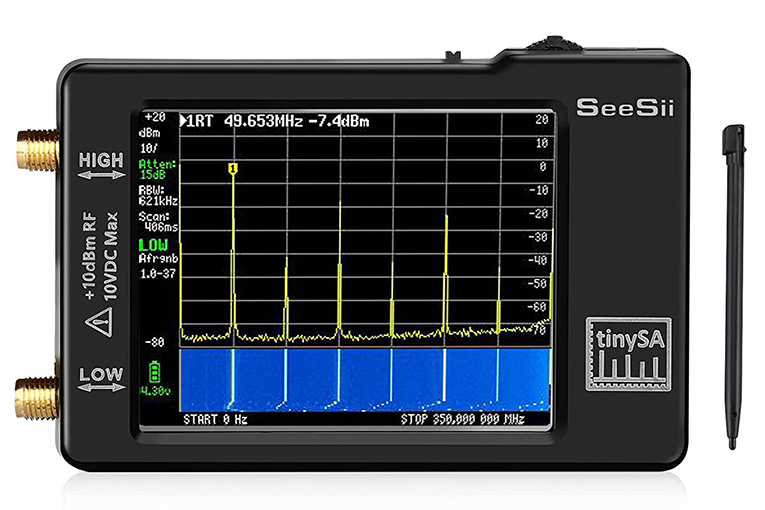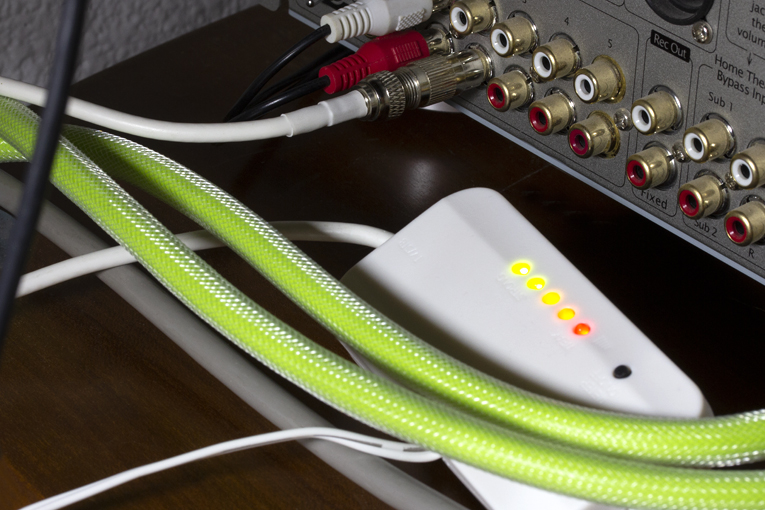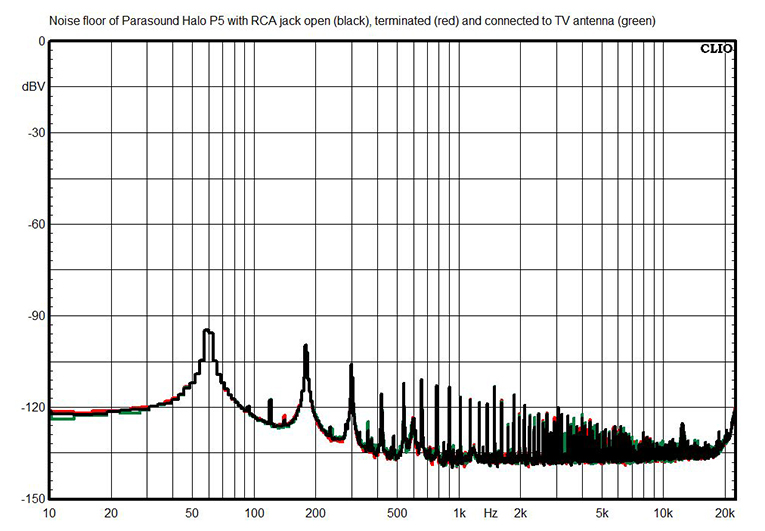I’m going to stray a little beyond the headphone beat this month, because I just can’t contain myself. Recording episode 12 of the SoundStage! Audiophile Podcast with Dennis Burger pushed me past my limit of tolerance for nonsensical claims that audio manufacturers don’t even try to back up with valid testing and meaningful data.
The claim that’s got me especially peeved is the notion that radio-frequency (RF) energy poses a danger to audio reproduction that must be dealt with through all manner of exotic, often expensive accessories. The product Dennis and I hammered on is the Ansuz Acoustics Sortz, a plug that you insert into the unused inputs and outputs of a piece of audio gear because these open outlets supposedly act as radio antennas, allowing radio-frequency energy to enter the audio component and, in this case, “bleeding into the system as annoying ‘white noise.’”

It’s not like those inputs couldn’t possibly permit some kind of interference, and with old-school preamps and integrated amps that use rotary input-selector switches, you could get a little bit of buzz when you switch to an open input (not when an open input is adjacent to the one you’re using). I can’t remember encountering this problem once in the last 40 or 50 years. I think I remember this happening with an old hand-me-down Heathkit tube integrated amp I got from my Dad in 1971, just in time for me to hear “Stairway to Heaven” the first time my local hippie FM station played it. That’s why they make terminators to short out these inputs and prevent signals from getting in through them. You can get generic ones on Amazon for a buck a pop, and Cardas has cooler-looking ones for $5, for those who don’t want to defile the back panel of their $20,000 preamp with generic doohickies from Amazon.
I don’t want to single out Ansuz Acoustics here, because innumerable manufacturers—makers of power-filtration products, cables, amplifiers, grounding devices, and various accessories—make similarly vague, unsubstantiated claims about the deleterious effects of RF interference on audio reproduction. In fact, Dennis and I reported on one of these before, in episode 4 of the podcast: the Fono Acustica Compás Speaker Ground System. And the phenomenon goes back at least to the early 1990s, when there was a brief craze for products that filter out the supposedly colossal amount of RF energy coming from the analog outputs of CD players—an artifact that seems to have sprung from an audio manufacturer’s imagination rather than from the display of an RF spectrum analyzer.
Some audio reviewers routinely repeat manufacturers’ claims about the horrors of RF. One recently noted that anti-RF devices “might be the most important front in the quest for better sound,” adding that “We know it [RF interference] is degenerative for our audio systems.”
How exactly do we know that? I can’t remember seeing any of these reviewers subject these claims to technical analysis, measurements, or controlled listening tests—or even demonstrate a working knowledge of the differences between RF signals and audio signals. They just attach the device and dutifully report audible improvements.

As I pointed out in my frenzied rant on the podcast, it’s easy to measure RF interference—and the amount by which your product reduces this interference—by using an RF spectrum analyzer. These used to cost a fortune, but now you can get serviceable ones for between $50 and $100 that can interface with a laptop PC. I bought one of these—the TinySA spectrum analyzer—because another publication assigned me to test TV antennas, and I thought it’d be worth a two-figure gamble to get a look at what these antennas are really pulling in. I was shocked at how well the TinySA worked—better, in ways, than the monstrous, costly analyzers I had borrowed for previous antenna tests. I have seen a few power-filtration products show the efficacy of their devices in reducing RF energy on power lines—but considering that a cheap inductor coil in series with the AC line will produce a measurable reduction in RF energy, that doesn’t impress me.
What would impress me is if a manufacturer showed the effect these RF-filtering devices have on an audio signal. That’s also easy—just connect the output of the audio component that the RF-killing device is used with to an audio spectrum analyzer. This could be something as simple as the TrueRTA PC app combined with a USB interface (the same rig I use for headphone isolation measurements) or a fancier, dedicated hardware/software package like the Audiomatica Clio (which I use for most of my other measurements). Just look at a real-time analysis of the audio spectrum without the RF-killing device and then connect the device and see if there’s any difference. (Or even better, they could set up a blind listening test and see if a half-dozen listeners can tell the difference to a statistically significant degree.)
I should confess here that I’ve been a bit of an RF geek ever since the late antenna magnate Neil Terk invited me to his company HQ to pow-wow with his engineers, who were crusty ex-military guys with little tolerance for BS. A quick side note that shows how honest their presentation was: As a thank-you for hauling myself all the way out to Long Island, Neil presented me with a plastic triceratops with rabbit-ear TV antennas in place of the horns. He explained that they’d thought about giving it away as a gag gift for a dealer conference, but decided against it when they found that it performed as well as some of the company’s $50-plus antennas.
So since the manufacturers and reviewers of RF-killing, audio-salvaging devices won’t put their devices to the test, I decided I would.
I didn’t have any anti-RF accessories on hand, but I came up with a test that might shed some light on claims about RF and audio systems. First, I connected my Clio analyzer to the right-channel output of my Parasound Halo P 5 preamp, and connected an Audioengine B1 Bluetooth receiver (the first non-analog source device I had handy) to analog input 1 of the preamp. I used my Samsung Galaxy S10 phone to generate a 1kHz sine wave, and set the volume of the preamp so that the 1kHz tone peaked at 0dBV (1Vrms) on the Clio’s spectrum analyzer. (Although the Halo P 5’s max output is specified as 7V, in a typical system and listening situation, a preamp’s output will rarely exceed 1V.) Then I turned off the tone and let the phone idle.
I ran a spectrum analysis of the preamp’s output with the jacks on all the other RCA inputs left open. Besides some 60-cycle hum at about -100dBV, and some lower-magnitude harmonics of this hum spaced at 120Hz intervals, the noise floor ran between -120 and -135dBV. Then I tried capping the adjacent right-channel input 2 with a generic terminator.

And then I put the pedal to the metal, so to speak, by creating the most nightmarish RF interference scenario I could muster—an RCA ANT3ME1 TV antenna, connected directly to the right channel of input 2—and ran another spectrum analysis. The ANT3ME1 (which is one of the most effective flat TV antennas I’ve tested) incorporates a useful signal-level meter; in this case, all five of the meter’s LEDs illuminated, indicating that very strong TV and FM radio signals were present. Then I ran another spectrum analysis.
As you can see from the chart below, the three spectrum analyses are practically identical. This being a measurement of a random element—noise—there’s no way they could be perfectly identical, but it’s clear that there are no meaningful differences among the three traces. Even the noise we do see in this chart—which is inherent to the source device and the preamp, not to RF interference—is far below the level of audibility. In a normal residential setting, that noise floor would be 40 to 60dB below the ambient noise level of the room. That’s roughly the sound-pressure level of a mosquito flying ten feet away—a sound that even the background noise in any studio or live recording you play would completely mask.

This result really shouldn’t come as a surprise. The Halo P 5’s frequency response is rated -3dB at 100kHz. This doesn’t mean that when the Halo P 5 is presented with radio frequencies in the megahertz or gigahertz bands, it throws a conniption, becomes completely dysfunctional, and produces “annoying ‘white noise.’” It means that the P 5 ignores these frequencies—just as it ignores the beam of a flashlight (another form of electromagnetic radiation).
It’s also worth noting that the RF signals in question are extremely weak compared with audio signals. When reception is excellent, the level produced at the terminals of a good TV antenna might be -30dBm—a millionth of a watt, roughly 0.007Vrms into a 50-ohm impedance. What’s the level of reception on a not-good antenna, such as a circuit board trace or an unterminated RCA jack? I could measure it, but at this point, why should I spend the time? The manufacturers who claim that RF pickup through these components is a problem should be including this information in their marketing materials.
My quick little experiment doesn’t prove that RF interference isn’t ever a problem with audio systems. But it does put the onus on manufacturers of RF-killing audio accessories to demonstrate the audibility of their products in an audio system—using measurements or controlled listening tests, not just the testimony of audio writers and enthusiasts who are easily influenced by marketing—and who are frightened that the audiophile community will shun them if they admit they can’t hear a difference.
. . . Brent Butterworth





